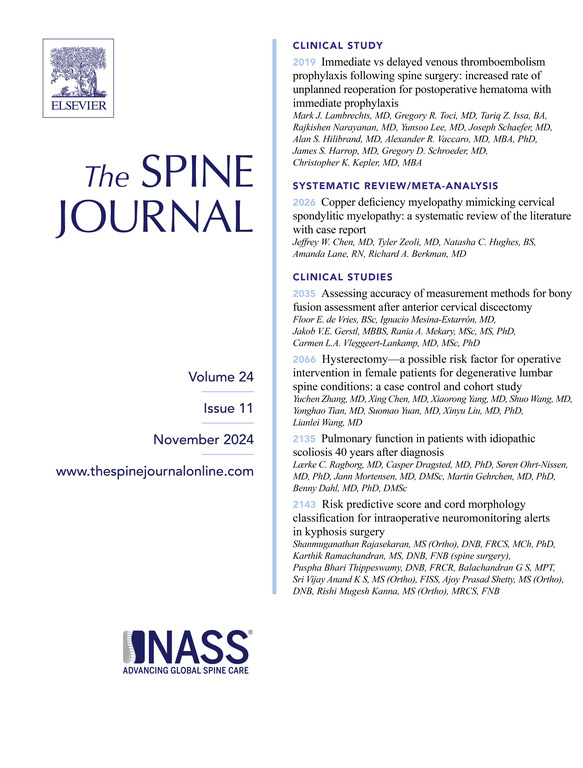原发性椎体骨髓炎的定义千差万别:用元流行病学方法探索统一诊断框架之路。
IF 4.9
1区 医学
Q1 CLINICAL NEUROLOGY
引用次数: 0
摘要
背景情况:原发性椎体骨髓炎(NVO)的发病率呈上升趋势,但临床疗效仍然不佳,复发率高且长期后遗症严重。2015 年《IDSA 临床实践指南》引发了关于 NVO 的学术活动热潮,揭示了该综合征的定义和众多同义词的交替使用。研究目的:系统总结这些定义,评估其内容、随时间推移的分布和主题聚类:研究设计/设置:对定义进行系统回顾的元流行病学研究:患者样本:对多个数据库进行了广泛搜索,目标是 2005 年至今的试验和队列研究,这些研究提供了 NVO 及其同义词的定义:结果测量:对构成定义的诊断标准进行分析,并根据诊断标准的可能组合对定义进行细分:我们采用布尔逻辑对已发表的定义进行了专题综合,每项纳入的研究都得出了一个或多个定义。我们使用八个预定义的诊断标准对定义进行了标准化,重点关注所使用的最小必要组合。使用桑基图对定义的组成部分进行了可视化:文献检索共发现 8460 篇参考文献,其中 171 项研究报告了 21963 名患者。其中 91.2% 为回顾性研究,7.6% 为前瞻性研究,1.2% 为 RCT 研究。大多数定义来自作者,29.2%的定义参考了资料来源。我们在文献中发现了 92 种独特的诊断标准组合。我们发现了 13 种主要模式,其中最常见的是临床特征与影像学相结合,其次是临床特征与影像学和微生物学相结合,最后是影像学与微生物学相结合:我们的研究结果表明,有必要共同努力制定标准化的诊断标准。我们主张专家们在未来达成德尔菲共识,建立统一的 NVO 诊断框架,强调临床特征和磁共振成像的核心要素,同时结合微生物学和组织病理学的见解,以改善患者预后并促进研究进展。本文章由计算机程序翻译,如有差异,请以英文原文为准。

Wide variability of the definitions used for native vertebral osteomyelitis: walking the path for a unified diagnostic framework with a meta-epidemiological approach
BACKGROUND CONTEXT
Native Vertebral Osteomyelitis (NVO) has seen a rise in incidence, yet clinical outcomes remain poor with high relapse rates and significant long-term sequelae. The 2015 IDSA Clinical Practice Guidelines initiated a surge in scholarly activity on NVO, revealing a patchwork of definitions and numerous synonyms used interchangeably for this syndrome.
PURPOSE
To systematically summarize these definitions, evaluate their content, distribution over time, and thematic clustering.
STUDY DESIGN/SETTING
Meta-epidemiological study with a systematic review of definitions.
PATIENTS SAMPLE
An extensive search of multiple databases was conducted, targeting trials and cohort studies dating from 2005 to present, providing a definition for NVO and its synonyms.
OUTCOME MEASURES
Analysis of the diagnostic criteria that composed the definitions and the breaking up of the definitions in the possible combinations of diagnostic criteria.
METHODS
We pursued a thematic synthesis of the published definitions with Boolean logic, yielding single or multiple definitions per included study. Using 8 predefined diagnostic criteria, we standardized definitions, focusing on the minimum necessary combinations used. Definition components were visualized using Sankey diagrams.
RESULTS
The literature search identified 8,460 references, leading to 171 studies reporting on 21,963 patients. Of these, 91.2% were retrospective, 7.6% prospective, and 1.2% RCTs. Most definitions originated from authors, with 29.2% referencing sources. We identified 92 unique combinations of diagnostic criteria across the literature. Thirteen main patterns emerged, with the most common being clinical features with imaging, followed by clinical features combined with imaging and microbiology, and lastly, imaging paired with microbiology.
CONCLUSIONS
Our findings underscore the need for a collaborative effort to develop standardized diagnostic criteria. We advocate for a future Delphi consensus among experts to establish a unified diagnostic framework for NVO, emphasizing the core components of clinical features and MRI while incorporating microbiological and histopathological insights to improve both patient outcomes and research advancements.
求助全文
通过发布文献求助,成功后即可免费获取论文全文。
去求助
来源期刊

Spine Journal
医学-临床神经学
CiteScore
8.20
自引率
6.70%
发文量
680
审稿时长
13.1 weeks
期刊介绍:
The Spine Journal, the official journal of the North American Spine Society, is an international and multidisciplinary journal that publishes original, peer-reviewed articles on research and treatment related to the spine and spine care, including basic science and clinical investigations. It is a condition of publication that manuscripts submitted to The Spine Journal have not been published, and will not be simultaneously submitted or published elsewhere. The Spine Journal also publishes major reviews of specific topics by acknowledged authorities, technical notes, teaching editorials, and other special features, Letters to the Editor-in-Chief are encouraged.
 求助内容:
求助内容: 应助结果提醒方式:
应助结果提醒方式:


